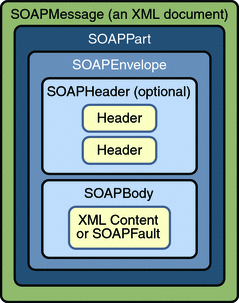SAAJ Messages
SAAJ messages follow SOAP standards, which prescribe the format for messages and also specify some things that are required, optional, or not allowed. With the SAAJ API, you can create XML messages that conform to the SOAP 1.1 or 1.2 specification and to the WS-I Basic Profile 1.1 specification simply by making Java API calls.
The Structure of an XML Document
An XML document has a hierarchical structure made up of elements, subelements, subsubelements, and so on. You will notice that many of the SAAJ classes and interfaces represent XML elements in a SOAP message and have the word element or SOAP (or both) in their names.
An element is also referred to as a node. Accordingly, the SAAJ API has the interface Node, which is the base class for all the classes and interfaces that represent XML elements in a SOAP message. There are also methods such as SOAPElement.addTextNode, Node.detachNode, and Node.getValue, which you will see how to use in the tutorial section.
What Is in a Message?
The two main types of SOAP messages are those that have attachments and those that do not.
Messages with No Attachments
The following outline shows the very high-level structure of a SOAP message with no attachments. Except for the SOAP header, all the parts listed are required to be in every SOAP message.
I. SOAP message
A. SOAP part
1. SOAP envelope
a. SOAP header (optional)
b. SOAP bodyThe SAAJ API provides the SOAPMessage class to represent a SOAP message, the SOAPPart class to represent the SOAP part, the SOAPEnvelope interface to represent the SOAP envelope, and so on. Figure 19–1 illustrates the structure of a SOAP message with no attachments.
Figure 19–1 SOAPMessage Object with No Attachments

Note –
Many SAAJ API interfaces extend DOM interfaces. In a SAAJ message, the SOAPPart class is also a DOM document. See SAAJ and DOM for details.
When you create a new SOAPMessage object, it will automatically have the parts that are required to be in a SOAP message. In other words, a new SOAPMessage object has a SOAPPart object that contains a SOAPEnvelope object. The SOAPEnvelope object in turn automatically contains an empty SOAPHeader object followed by an empty SOAPBody object. If you do not need the SOAPHeader object, which is optional, you can delete it. The rationale for having it automatically included is that more often than not you will need it, so it is more convenient to have it provided.
The SOAPHeader object can include one or more headers that contain metadata about the message (for example, information about the sending and receiving parties). The SOAPBody object, which always follows the SOAPHeader object if there is one, contains the message content. If there is a SOAPFault object (see Using SOAP Faults), it must be in the SOAPBody object.
Messages with Attachments
A SOAP message may include one or more attachment parts in addition to the SOAP part. The SOAP part must contain only XML content; as a result, if any of the content of a message is not in XML format, it must occur in an attachment part. So if, for example, you want your message to contain a binary file, your message must have an attachment part for it. Note that an attachment part can contain any kind of content, so it can contain data in XML format as well. Figure 19–2 shows the high-level structure of a SOAP message that has two attachments.
Figure 19–2 SOAPMessage Object with Two AttachmentPart Objects

The SAAJ API provides the AttachmentPart class to represent an attachment part of a SOAP message. A SOAPMessage object automatically has a SOAPPart object and its required subelements, but because AttachmentPart objects are optional, you must create and add them yourself. The tutorial section walks you through creating and populating messages with and without attachment parts.
If a SOAPMessage object has one or more attachments, each AttachmentPart object must have a MIME header to indicate the type of data it contains. It may also have additional MIME headers to identify it or to give its location. These headers are optional but can be useful when there are multiple attachments. When a SOAPMessage object has one or more AttachmentPart objects, its SOAPPart object may or may not contain message content.
SAAJ and DOM
The SAAJ APIs extend their counterparts in the org.w3c.dom package:
-
The Node interface extends the org.w3c.dom.Node interface.
-
The SOAPElement interface extends both the Node interface and the org.w3c.dom.Element interface.
-
The SOAPPart class implements the org.w3c.dom.Document interface.
-
The Text interface extends the org.w3c.dom.Text interface.
Moreover, the SOAPPart of a SOAPMessage is also a DOM Level 2 Document and can be manipulated as such by applications, tools, and libraries that use DOM. For details on how to use DOM documents with the SAAJ API, see Adding Content to the SOAPPart Object and Adding a Document to the SOAP Body.
- © 2010, Oracle Corporation and/or its affiliates
